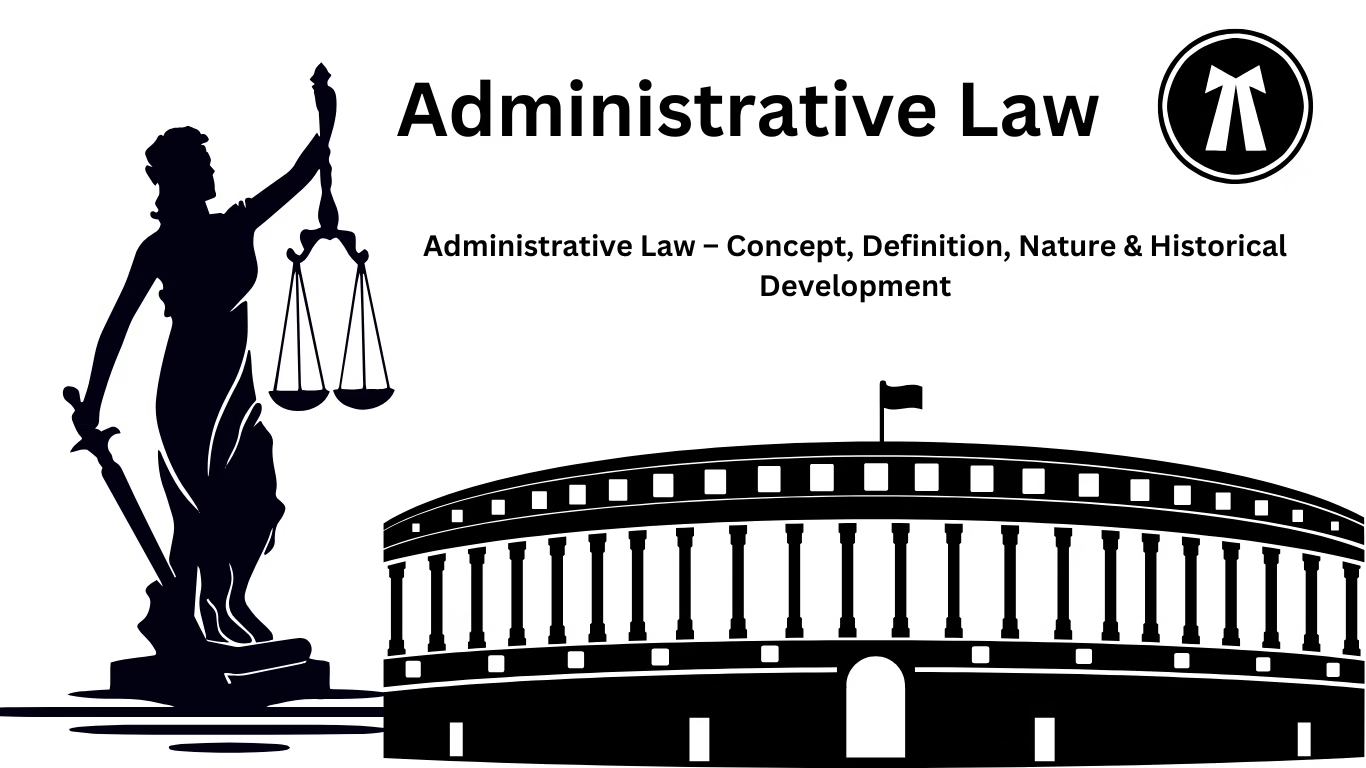Here’s a bilingual (Hindi & English) detailed introduction to Administrative Law, covering its meaning, concept, historical development, sources, relationship with constitutional law, rule of law, separation of powers, classification of administrative functions, and Droit Administratif.
Administrative Law (प्रशासनिक विधि)
1. Meaning (अर्थ)
Administrative Law refers to the body of law that governs the activities of administrative agencies of the government. It includes the rules, regulations, and legal principles that ensure governmental authorities act lawfully and fairly.
प्रशासनिक विधि वह विधि है जो सरकारी प्रशासनिक एजेंसियों की शक्तियों और कार्यों को नियंत्रित करती है। इसमें वे सभी नियम, विनियम और कानूनी सिद्धांत शामिल होते हैं, जो यह सुनिश्चित करते हैं कि सरकारी अधिकारी विधि-सम्मत और निष्पक्ष रूप से कार्य करें।
2. Administrative Law – Concept, Definition, Nature & Historical Development
(प्रशासनिक विधि – संकल्पना, परिभाषा, प्रकृति एवं ऐतिहासिक विकास)
Concept & Definition (संकल्पना एवं परिभाषा)
Administrative law is concerned with the organization, powers, duties, and functions of public authorities. It ensures that public officials act within their legal limits.
परिभाषाएँ:
- Ivor Jennings – “Administrative law is the law relating to administration. It determines the organization, powers, and duties of administrative authorities.”
- Wade & Forsyth – “Administrative law is the branch of public law which controls the exercise of governmental power.”
Nature (प्रकृति)
- Public Law – It is a branch of public law.
- Dynamic & Evolving – Changes as per governance needs.
- Prevents Abuse of Power – Ensures accountability of government.
- Regulates Delegated Legislation – Governs rules made by administrative bodies.
Historical Development (ऐतिहासिक विकास)
- England: Emerged after the industrial revolution to regulate the activities of the executive branch.
- USA: Developed to ensure constitutional rights and protect against arbitrary administrative actions.
- India: Evolved from British colonial rule and later expanded through judicial precedents and legislative actions.
3. Relationship with Constitutional Law (संविधानिक कानून से संबंध)
- Constitutional Law is the supreme law, while Administrative Law derives its authority from the Constitution.
- Constitutional law sets broad principles, whereas administrative law governs day-to-day governmental operations.
- Courts review administrative actions based on constitutional principles like fundamental rights, natural justice, and due process.

4. Rule of Law & Separation of Power (कानून का शासन और शक्तियों का पृथक्करण)
Rule of Law (कानून का शासन)
The doctrine of Rule of Law, given by A.V. Dicey, ensures that:
- Supremacy of Law – No one is above the law.
- Equality Before Law – Equal treatment for all citizens.
- Legal Protection of Rights – Laws should be fair and just.
Separation of Powers (शक्तियों का विभाजन)
Proposed by Montesquieu, this principle states that:
- Legislative (विधायिका) – Makes laws.
- Executive (कार्यपालिका) – Implements laws.
- Judiciary (न्यायपालिका) – Interprets laws.
It prevents tyranny and misuse of power by ensuring that one organ does not interfere with another’s function.
5. Classification of Administrative Functions & Distinction (प्रशासनिक कार्यों का वर्गीकरण और भिन्नता)
Administrative functions are broadly classified into:
- Legislative Functions – When administrative bodies make rules (e.g., delegated legislation).
- Executive Functions – Implementation of laws and regulations.
- Judicial Functions – When administrative bodies act like courts (e.g., tribunals).

Distinction (अंतर):
- Legislative Function – Makes new rules.
- Executive Function – Implements those rules.
- Judicial Function – Decides disputes arising from those rules.
6. Droit Administratif (फ्रांस का प्रशासनिक विधि तंत्र)
The French system of Droit Administratif is a separate system of administrative courts where government agencies are not subject to ordinary courts but special administrative tribunals.
Features of Droit Administratif:
- Dual Court System – Separate courts for administrative disputes.
- Council of State (Conseil d’État) – The highest administrative court in France.
- Protects Citizens’ Rights – Ensures government accountability.
Comparison with India & UK
- India & UK follow Rule of Law where the same courts handle both governmental and private disputes.
- France follows Droit Administratif, where government disputes are handled separately.
प्रशासनिक विधि क्या है?*
- प्रशासनिक विधि सरकार के कार्यकारी अंग (Executive) के अधिकारों, शक्तियों, और दायित्वों को परिभाषित करने वाली विधि है।
- यह यह सुनिश्चित करती है कि सरकारी संस्थाएँ कानून के अनुसार कार्य करें और नागरिकों के अधिकारों की रक्षा हो।
- यह विधि लोक प्रशासन और न्यायिक समीक्षा (Judicial Review) से संबंधित होती है।
📌 Example:
- यदि कोई सरकारी अधिकारी अपनी शक्तियों का दुरुपयोग करता है, तो प्रशासनिक विधि के तहत उसकी समीक्षा की जा सकती है।
- सूचना का अधिकार अधिनियम (RTI Act, 2005) प्रशासनिक विधि का एक उदाहरण है।
2. प्रशासनिक विधि: परिभाषा, प्रकृति, ऐतिहासिक विकास, स्रोत, और संवैधानिक विधि से संबंध
(A) परिभाषा (Definition of Administrative Law)
प्रशासनिक विधि की विभिन्न परिभाषाएँ:
- वेडेल (Wade & Phillips): प्रशासनिक विधि वह विधि है, जो सरकार के प्रशासनिक कार्यों को नियंत्रित करती है।
- आईवोर जेनिंग्स (Ivor Jennings): प्रशासनिक विधि वह विधि है, जो सरकार और नागरिकों के बीच संबंधों को नियंत्रित करती है।
- के.सी. डेवीस (K.C. Davis): यह वह विधि है, जो सरकारी अधिकारियों के कार्यों की न्यायिक समीक्षा सुनिश्चित करती है।
(B) प्रकृति (Nature of Administrative Law)
- गतिशील विधि (Dynamic Law): यह समय के साथ विकसित होती है और सामाजिक-राजनीतिक आवश्यकताओं के अनुसार बदलती है।
- विधायिका और कार्यपालिका का संयोजन (Combination of Legislature & Executive): प्रशासनिक विधि में कार्यपालिका को सीमित विधायी शक्तियाँ दी जाती हैं।
- न्यायिक समीक्षा की अनुमति (Permits Judicial Review): प्रशासनिक विधि न्यायपालिका को सरकारी निर्णयों की समीक्षा करने की शक्ति देती है।
(C) ऐतिहासिक विकास (Historical Development of Administrative Law)
📜 प्रशासनिक विधि का विकास मुख्य रूप से दो प्रमुख प्रणालियों में हुआ:
(1) इंग्लैंड (British Administrative Law)
- इंग्लैंड में “रूल ऑफ लॉ” (Rule of Law) प्रशासनिक विधि का आधार बना।
- डाइस (A.V. Dicey) ने प्रशासनिक विधि की व्याख्या कानून के शासन (Rule of Law) के सिद्धांत से की।
(2) फ्रांस (French Administrative Law)
- “द्रॉइट एडमिनिस्ट्रेटिव” (Droit Administratif) की अवधारणा विकसित हुई, जिसमें प्रशासनिक न्यायालयों (Administrative Courts) की स्थापना की गई।
- फ्रांस में प्रशासनिक मामलों को सामान्य न्यायालयों के बजाय विशेष न्यायालयों में सुना जाता है।
(D) प्रशासनिक विधि के स्रोत (Sources of Administrative Law)
प्रशासनिक विधि के मुख्य स्रोत हैं:
- संविधान (Constitution) – प्रशासनिक विधि की नींव संविधान में निहित होती है।
- विधायी अधिनियम (Legislative Enactments) – संसद द्वारा बनाए गए कानून जैसे RTI Act, 2005।
- न्यायिक निर्णय (Judicial Decisions) – अदालतों द्वारा दिए गए निर्णय प्रशासनिक विधि का हिस्सा बनते हैं।
- कार्यकारी आदेश (Executive Orders) – सरकार द्वारा जारी किए गए नियम और अधिसूचनाएँ।
- संविदाएं (Contracts) – सरकार द्वारा किए गए अनुबंध भी प्रशासनिक विधि के अंतर्गत आते हैं।
(E) संवैधानिक विधि और प्रशासनिक विधि के बीच संबंध (Relationship Between Constitutional & Administrative Law)
📌 संवैधानिक विधि (Constitutional Law) और प्रशासनिक विधि में अंतर:
| विषय | संवैधानिक विधि | प्रशासनिक विधि |
|---|---|---|
| परिभाषा | संविधान से संबंधित विधि | प्रशासन से संबंधित विधि |
| शक्ति | विधायिका, कार्यपालिका, और न्यायपालिका को नियंत्रित करती है | केवल कार्यपालिका को नियंत्रित करती है |
| उद्देश्य | मौलिक अधिकारों की रक्षा करना | प्रशासनिक न्याय और कुशल प्रशासन सुनिश्चित करना |
3. कानून का शासन और शक्तियों का विभाजन (Rule of Law & Separation of Powers)
(A) कानून का शासन (Rule of Law)
📌 “रूल ऑफ लॉ” (Rule of Law) का अर्थ:
- सभी व्यक्ति कानून के अधीन हैं और कोई भी कानून से ऊपर नहीं है।
- डाइस (A.V. Dicey) के अनुसार, “कानून का शासन” तीन सिद्धांतों पर आधारित है:
- व्यक्तिगत स्वतंत्रता की सुरक्षा।
- समान कानून का पालन।
- न्यायपालिका की स्वतंत्रता।
(B) शक्तियों का विभाजन (Separation of Powers)
- मॉन्टेस्क्यू (Montesquieu) ने इस सिद्धांत को विकसित किया।
- यह सरकार के तीन अंगों – विधायिका, कार्यपालिका, और न्यायपालिका को अलग-अलग करने पर जोर देता है।
📌 भारत में शक्तियों का विभाजन आंशिक रूप से लागू होता है, जबकि अमेरिका में यह पूर्ण रूप से लागू होता है।
4. प्रशासनिक कार्यों का वर्गीकरण और उनके बीच अंतर (Classification of Administrative Functions & Distinction Between Them)
प्रशासनिक कार्यों को तीन भागों में विभाजित किया जाता है:
- कार्यकारी (Executive) – सरकारी अधिकारियों द्वारा लिए गए निर्णय।
- विधायी (Legislative) – प्रशासनिक एजेंसियों द्वारा बनाए गए नियम।
- न्यायिक (Judicial) – प्रशासनिक न्यायाधिकरण (Tribunals) द्वारा लिए गए फैसले।
5. द्रॉइट एडमिनिस्ट्रेटिव (Droit Administratif)
📌 “Droit Administratif” फ्रांस की प्रशासनिक विधि प्रणाली है, जिसमें प्रशासनिक विवादों के निपटारे के लिए अलग न्यायालय होते हैं।
📌 इसमें सरकारी अधिकारियों के खिलाफ मुकदमे सामान्य अदालतों में नहीं बल्कि विशेष प्रशासनिक न्यायालयों में दायर किए जाते हैं।
भारत और इंग्लैंड में “रूल ऑफ लॉ” लागू होता है, जबकि फ्रांस में “Droit Administratif” लागू होता है।
media law is public low chacket
निष्कर्ष (Conclusion)
✅ प्रशासनिक विधि सरकारी प्रशासन को नियंत्रित करने वाला एक महत्वपूर्ण कानूनी क्षेत्र है।
✅ यह विधि नागरिकों के अधिकारों की सुरक्षा और प्रशासनिक न्याय सुनिश्चित करती है।
✅ प्रशासनिक विधि संवैधानिक विधि से अलग है, लेकिन दोनों का उद्देश्य कानून व्यवस्था बनाए रखना है।

